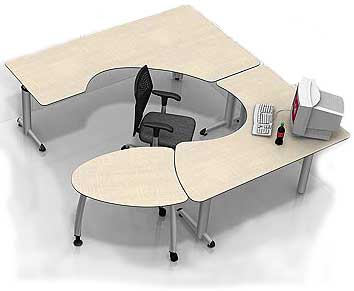Alleviate Back & Muscle Pain with These Workstation Modifications

More workdays are missed because of back pain than any other ailment, according to the American Chiropractic Association. Not only do workers lose days of productivity, but a desk job can actually be hazardous to their health. While it’s traditionally assumed that manual labor jobs are more dangerous, sitting in a chair all day with poor posture can, according to Spine-health.com, damage spinal structures and contribute to or worsen back pain.
The good news is that this is preventable. As you’re designing or redesigning a workplace, you can take certain precautions to ensure that your employees will be comfortable, productive, and have good spine and back health in the long-term.
The Occupational Health & Safety Administration (OSHA) advises that the keys to a comfortable and safe workplace include properly adjusting the chair, desk, monitor, and keyboard.
Computer Chairs
For an employee who sits in front of a desk or computer, the most important piece of equipment is a well-designed and properly adjusted chair. A good chair provides back, leg, buttock, and arm support. It also reduces contact stress, forceful exertion, and awkward posture. The more the chair can be adjusted to each individual’s body and comfort, the better. Ideally, the chair should also accommodate the user sitting in multiple postures during the day. When selecting office chairs, look for the following:
- Chairs should have lumbar (lower back region) support. Because your lumbar spine has an inward curve, if you sit for long periods without support, you could slouch and strain the structures in the lower spine. The good news is that a chair can be easily retrofitted for lumbar support with a rolled up towel or small pillow.
- The seat height should be adjustable so that the user’s feet are flat on the floor, thighs horizontal, and arms even with the height of the desk.
- The chair’s armrests should be adjustable so that the user’s arms can rest comfortably, with shoulders relaxed while typing. This means that elbows and lower arms are resting lightly and forearms are not on the armrests while typing.
- Choose desk chairs that can swivel enough so that the user can reach each area of his or her desk without straining.
Computer Components
For employees who work at computer workstations, their space should be such that they avoid forceful exertion, awkward posture, and overhead glare, which can lead to excessive fatigue, eyestrain, and neck and back pain.
First, the monitor must be at a distance and angle that will not cause eyestrain. If the monitor is too far away, the user will lean forward and strain both the eyes and the torso because the backrest is not providing support. If it’s too close, the eyes could work harder to focus and cause the user to sit in an awkward posture (like typing with arms outstretched or reclining in the chair). For most people, the preferred distance is 20-40 inches from eyes to monitor. If the desk is too shallow, try moving the desk farther from the wall or divider, or place the monitor in the corner of the workspace if there’s enough room. You can also install an adjustable keyboard tray that can be modified to the user’s comfort.
Second, the monitor should be directly in front so that the user’s whole body is facing forward as he or she views the screen. If the user is reviewing printed material, the printed sheets should be directly in front, with the monitor at only a slight turn to the side. As well, the monitor should be at or slightly below eye level, but not above.
Desk and Workspace
While plenty of employers prefer that a desk’s surface remain clutter-free so that the office environment looks nice, the area beneath the desk should be clutter-free as well for other reasons. Specifically, each person at the workspace needs to have ample room for his or her legs and feet. Discomfort, inefficient performance, generalized fatigue, circulation restriction, and contact stress from inability to frequently change postures are often the result of users sitting too far away from computer components.
For more information on how to create a safe and healthy work environment, review OSHA’s Computer Workstation Checklist.
 The Daily Dose
The Daily Dose
Comments are closed.